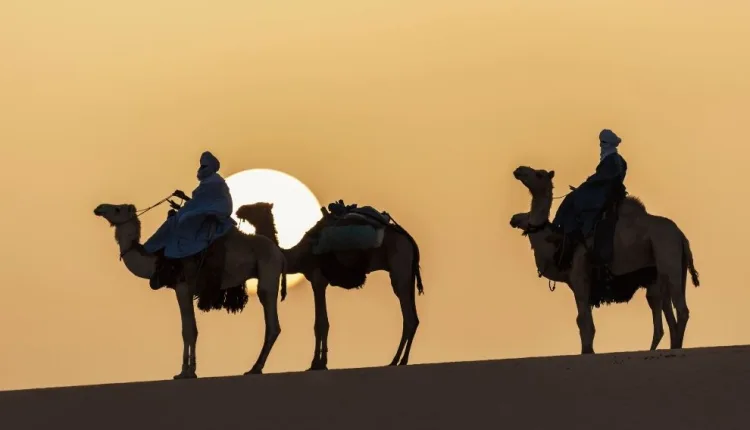
What Did the Messenger of God Typically Wear?
The Prophet Muhammad ﷺ would not wear mono-type clothing all the time. In general, He would wear a “harmani.”1 He used black, leather socks that Negus sent him. The end of his turban would sometimes hang down towards His blessed chest and sometimes towards his shoulders. His turban would mostly be black. He used to wear a cap under his turban. He never wore a pointed cap or coif. He said “What makes us different from the polytheists is that we wear a cap under the turban.”2
Our Prophet ﷺ liked wearing a dress called “qamis.”3 Qamis is a type of shirt stretching out from head to foot. It is said that our Prophet ﷺ liked it because it was not a two-piece clothing like “rida” and “izar” and covered the whole body. “Qamis” is generally made of cotton fabric. The sleeves of our Prophet’s shirts would stretch down to His wrists.4
He used to like striped fabric on dressing.5 It is called “Hibara” in Arabic. Hibara is a green fabric pertaining to Yemen. He liked green colored dresses, since the dresses that the people of Paradise will wear will be green. He would sometimes wear Damascus loose robes. When he was making wudu, He had to take off their sleeves because rolling them up was not possible due to their tightness. He also wore Nushiravan “Harmani” that had silky embroidery at their pockets and collars. After the Prophet’s death, the respected Aisha (may God be pleased with her) told that “the Messenger of God ﷺ passed away within these clothes” taking out a patched cardigan and broadcloth sarong.
Praise and Prayer
When our Prophet ﷺ was preparing to wear new clothing, He would pray to God (may He be glorified and exalted) with the name of that dress. For example, he would pray, “Thanks be to Allah who made this turban a dress to us” if He wore a turban; “Thanks be to Allah who made this shirt a dress to us”; if he wore a shirt; “Thanks be to Allah who made this scarf a dress to us” if he wore a scarf.6
When our Prophet wore new clothing, He would pray “O Allah, all praise is to You, just as You have dressed me, I seek Your blessings of it and the blessings of what it is made of and I seek protection and Your refuge from all evil and the evil of that which it is made of.”7
Color Preference
As understood from several narrations, the Messenger of God ﷺ dressed in almost all colors, such as black, red, green, yellow. However, His favorite color in clothing was white.8 He stated “white is the most beautiful one among colors” regarding white color.9

Which Shoes Did the Messenger of God Prefer?
He would sometimes wear a cloth made of plain striped fabric. His shoes were a type of shoe with a flat sole and tied over feet.
His Elegance
The Messenger of God ﷺ never liked vanity. However, He would sometimes wear valuable and good-looking clothing, especially when they were sent as gifts. Abdullah ibn Abbas (may God be pleased with him) put on a dress made of the most valuable fabrics from Yemen when he visited Haruriyyah as an envoy.
When Haruriyyah said:
– O, Ibn Abbas, what kind of clothes is this? Ibn Abbas replied:
– Do you object to my dressing style? I saw the Messenger of God ﷺ in the most beautiful dresses.10
Some rulers and local chiefs sent the Messenger of God ﷺ valuable clothing as gifts. The Messenger of God ﷺ accepted those and sometimes wore them.
For more information, one can explore the “Clothes” section in Abu Dawud’s Sunan.
Footnotes
- “Harmani” is a long, sleeveless, wide skirted type of coat or cloak that covers whole body.
- Abu Dawud, 2/452; Tirmidhi, 4/247; Al-Tabarani, Al-Mu’jam Al-Kabir, 5/71
- Abu Dawud, 2/240; Tirmidhi, 4/ 238; Ibn Majah, 2/1183
- Abu Dawud, 2/441
- Bukhari, 5/2188; Muslim, 2/651; Abu Dawud, 2/208; Tirmidhi, 3/321
- Tirmidhi, 4/239; Ahmad ibn Hanbal, 3/50
- Ahmad Ibn Hanbal, 3/50; Ibn Hibbân, Sahîh, 12/239
- Bukhari, 5/2193; Muslim, 1/94; Ahmad ibn Hanbal, 5/166
- Abu Dawud, 2/401, 449; Nasai, 4/34; Ahmad ibn Hanbal, 1/247, 328, 363, 5/10
- Al-Tabarani, Al-Mu’jam Al-Kabir, 10/257
